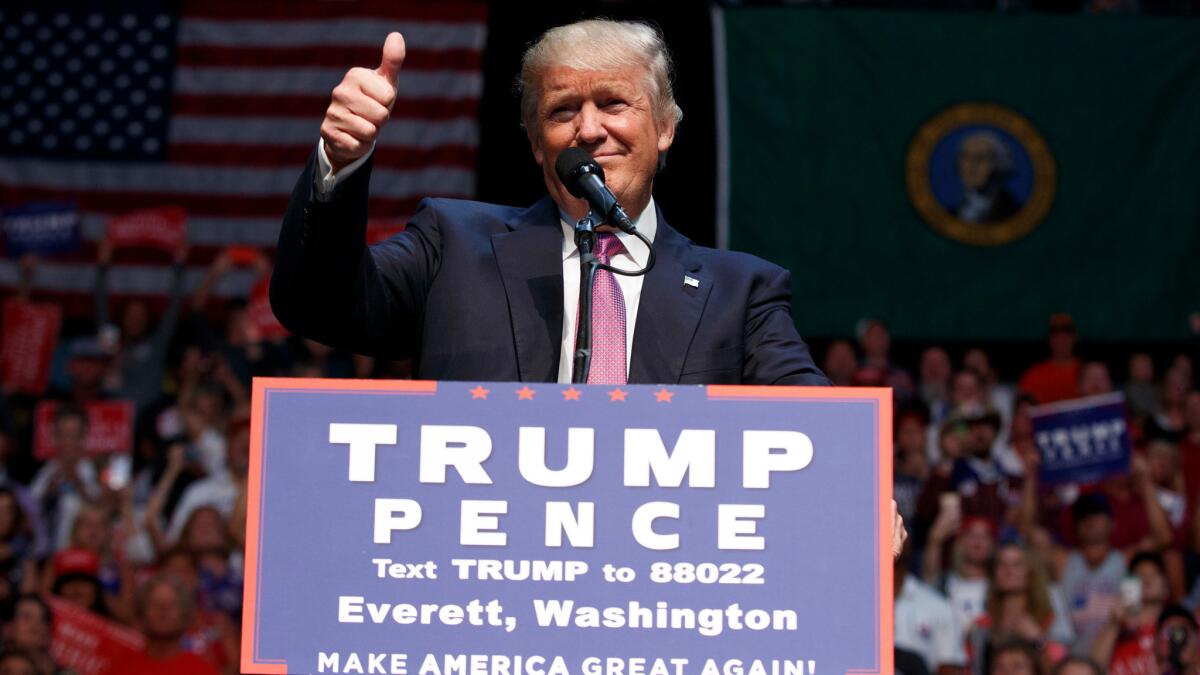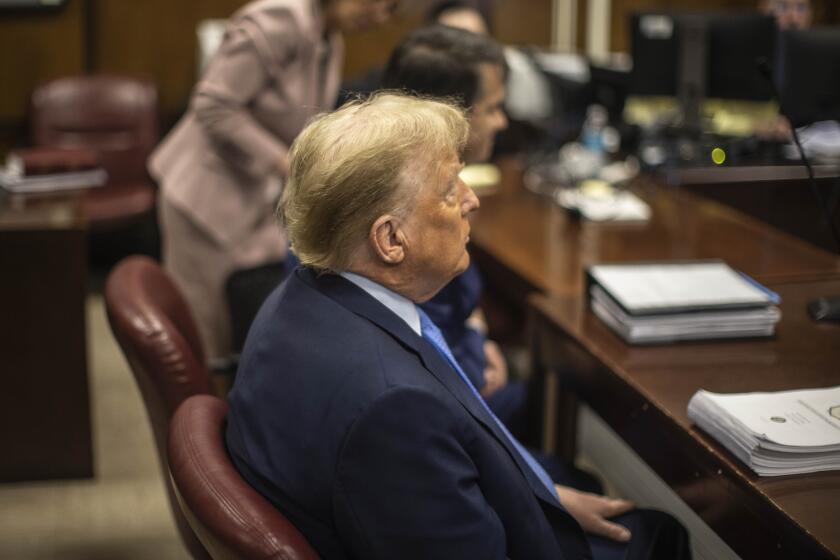Donald Trump still has a path to victory, but it’s a tough one, USC/L.A. Times poll shows

Although he trails in nearly all national surveys and polls of most battleground states, Donald Trump still has a potential route to victory, albeit a difficult one that would require him to coax many people who sat out the last election to vote this time around, the USC Dornsife/Los Angeles Times Daybreak tracking poll finds.
The existence of a bloc of disaffected voters large enough to potentially swing the election Trump’s way is the main finding from an analysis of the first eight weeks of the daily tracking poll.
Whether Trump can convert a significant number of those potential supporters into voters over the final two months of the presidential campaign could determine whether the election ends up as a close contest or a runaway for Hillary Clinton.
That group of potential voters also helps explain why the Daybreak poll’s results have consistently been more favorable to Trump than other major surveys.
The key group driving that result are people who sat out the 2012 election but say they plan to vote this year. Trump, who’s due to give a major speech on immigration Wednesday, leads among them in the poll. He trails Clinton among those who voted four years ago or were too young to do so.
The design of the Daybreak poll means it reflects, more strongly than some other surveys, the views of those who didn’t vote before but say they will this year. As a result, the poll presents something of a best-case scenario for Trump — one in which he succeeds in getting large numbers of previous nonvoters to cast ballots for him.
Even that best case is a problematic one for the Republican nominee since he seldom does better than a tie in the poll’s results. For the last two weeks, even as most polls have shown Clinton with a significant edge over Trump, the Daybreak poll has shown the two candidates roughly even, trading narrow leads back and forth. The poll also shows that a large percentage of voters remain uncertain about their choice.
As of Tuesday morning, the poll showed Trump ahead 45%-42%, well within the margin of error.
Trump’s situation is even more challenging because of the difficulty of turning nonvoters into voters, a task for which Trump’s campaign may be especially ill-suited.
Trump has not spent money on the sort of sophisticated, but labor-intensive and expensive, turnout efforts that delivered victories to President George W. Bush in 2004 and President Obama in 2008 and 2012. In one battleground state after another, reporters have found his campaign lacking even rudimentary get-out-the-vote operations.
Some of Trump’s campaign rhetoric also may work against him. Early in August, for example, the Daybreak poll found a notable decline in Trump supporters’ estimate of how likely they were to vote. The drop came shortly after Trump began making widely publicized claims that the election was rigged against him.
The timing could be coincidental, but might also indicate that the rhetoric about rigged elections was counterproductive by making some of Trump’s supporters see voting as futile.
In contrast with the Daybreak poll, other surveys have shown the race tightening recently, but not enough to erase Clinton’s lead. Averages of recent public polls have Clinton ahead by six or seven percentage points.
Clinton also holds significant leads in polls of key states that have been closely divided in recent elections. Those include Virginia and Colorado, where the Democrats have stopped buying additional television advertising time because they no longer feel it necessary, and Pennsylvania and Wisconsin, must-win states for Trump where the most recent surveys show him losing by big margins.
The Daybreak poll’s divergence from that trend has attracted attention from all sides, with Republicans citing it as a hopeful indicator and Democrats as a warning against complacency.
The poll has a very different methodology than most other surveys. Some elements of the methodology have drawn criticism from some analysts; others have defended it.
Analysis of the polling data makes clear where most of the difference between the Daybreak poll and other surveys comes from. The poll respondents who did not vote in 2012 are disproportionately whites who did not graduate from college — Trump’s strongest supporters. Almost six in 10 of the 2012 nonvoters fall into that group. By contrast, non-college-educated whites make up about four in 10 of the poll respondents who did vote four years ago.
Given those demographics, it’s no surprise that Trump does significantly better with the 2012 nonvoters than with people who cast a ballot last time around. And because the Daybreak poll includes more of those previous nonvoters than some other surveys, Trump performs better in its forecast.
As of Tuesday, Trump led by seven points among those who could have voted in 2012 but didn’t. Clinton led by two points among those who voted four years ago or were too young to vote then, the Daybreak poll found. Among whites without a college degree who did not vote in 2012, Trump led Clinton by more than 2-1, the poll found.
The Daybreak poll may represent the views of those potential voters more heavily than most surveys do because of the way it’s structured.
All polls adjust their data to ensure that their samples match known demographics — the correct share of men versus women, young versus old, white versus nonwhite — a process known as weighting.
The Daybreak poll goes a step further and weights the sample to match how people voted in 2012. Because of that weighting, about 40% of the poll respondents are people who were old enough to vote four years ago, but did not.
That share accurately reflects the U.S. population, although it could overstate the impact those people will have on this year’s election.
To take into account the fact that many people don’t vote, the poll asks respondents to rate their likelihood of voting on a scale from 0 to 100. The more likely they say they are to vote, the more heavily they weigh in the poll’s outcome. That’s very different from the approach most surveys take in which a person either is included entirely or excluded entirely from the poll sample.
Currently, those who did not vote in 2012 give themselves on average a 58% chance of voting this time. That’s considerably less than the 92% average given by those who did vote four years ago. But it may still be too high — surveys routinely find that people overestimate their likelihood of voting.
If those who did not vote four years ago overestimate how likely they are to vote this time, the poll could be weighted too heavily by their views. Weighting the sample to match what people say about their 2012 vote can introduce other errors as well.
By contrast, standard polls can cause an error in the opposite direction. They generally use a person’s voting history as one factor in a process designed to screen for likely voters. Those polls may discard entirely the views of many people who didn’t vote in past elections. Not all polling organizations disclose how they screen for likely voters.
While the Daybreak poll may overestimate the number of previous nonvoters who will cast ballots this time round, a strong likely voter screen can blind a poll to the possibility that an unconventional candidate — like Trump — may draw in voters who haven’t participated before.
But polls are snapshots. Until all the votes are tallied after election day, there’s no way to know which approach best fits this year’s electorate.
For more on Politics and Policy, follow me @DavidLauter
MORE CAMPAIGN 2016
Donald Trump to travel to Mexico to meet with Mexican president
Huma Abedin is Hillary Clinton's closest aide, and now she might be a liability
Who’s Winning? Daily track of Clinton and Trump’s support
Get the L.A. Times Politics newsletter
Deeply reported insights into legislation, politics and policy from Sacramento, Washington and beyond. In your inbox three times per week.
You may occasionally receive promotional content from the Los Angeles Times.




